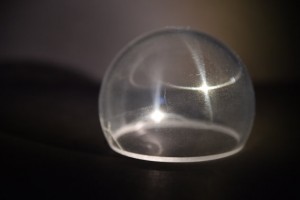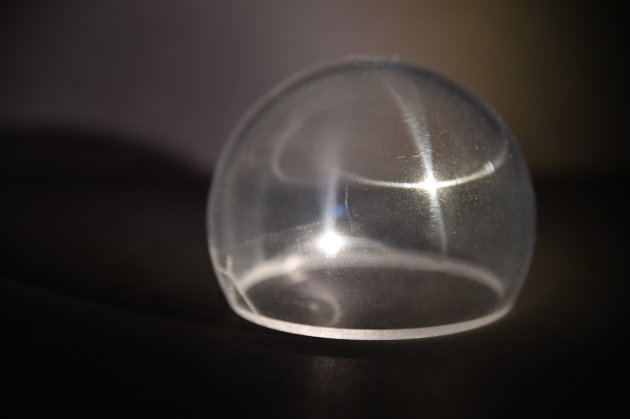There are currently three main forms of commercially-produced bulletproof glass: acrylic, polycarbonate and glass-clad polycarbonate. Bulletproof acrylic is comprised of one solid sheet of acrylic that is at least 1″ thick. Ballistic polycarbonate and glass-clad polycarbonate security glass are manufactured by layering sheets of glass with sheets of polycarbonate which are then tempered and laminated to create a finished product.
Recently, Navy researchers made an astounding breakthrough in the development of bulletproof glass by manufacturing a transparent, bulletproof material called Spinel, also known as the mineral magnesium aluminate. It is formed by heating a synthetic powdered clay and pressing it under vacuum into transparent sheets.

This new bulletproof material has advantages over traditional bulletproof glass:
 Flexibility: While polycarbonate can be manufactured into various shapes without cracking, Spinel can be formed into virtually any shape, as seen in the image of the transparent dome.
Flexibility: While polycarbonate can be manufactured into various shapes without cracking, Spinel can be formed into virtually any shape, as seen in the image of the transparent dome.- Strength and Durability: Spinel is much stronger and more durable than glass, having the ability to withstand sand and rain erosion. Glass-clad polycarbonate can be layered thicker to offer higher levels of bullet resistance. It also holds up in high-traffic areas, weathers excellently, and carries ratings for forced entry, explosive blasts, and hurricane winds. However, the trade-off for this strength is that the material has poor light transmission.
- Better Infrared Transmission: Unlike any commercially-produced bulletproof glass available today, Spinel does not block the infrared wavelength of light. For military applications, this is beneficial because it could be used to protect the surveillance camera of an unmanned aerial vehicle (UAV) or an HEL-MD laser without obstructing the device’s operation.
- Lightweight: Spinel is significantly lighter than standard bulletproof glass, which could prove advantageous in retrofitting older facilities that weren’t built to accommodate the weight of today’s commercially-produced ballistic glass.
It may be a long time before Spinel is used in commercial applications. In the meantime, there are plans within military branches to share the production process with the rest of the defense industry.
NEXT STEPS:
- Sign up for our newsletter to stay up-to-date with the latest industry news.
- Download our Ultimate Guide to Bulletproof Glass and Bullet Resistant Barriers infographic.
- Visit our blog for other industry news.
Photo courtesy of www.engadget.com.


